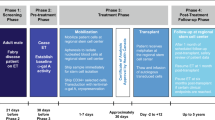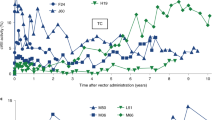Abstract
Host immune responses limit the duration of expression of transgenes introduced by recombinant adenoviruses, preclude gene transfer upon vector readministration and cause liver injury. CTLA4Ig inhibits immune response by blocking the co-stimulatory interaction between CD28 on T cells and B7 on antigen-presenting cells. We have constructed a recombinant adenovirus, Ad-hUGT1A1-CTLA4Ig that coexpresses human bilirubin-uridinediphosphoglucuronate glucuronosyltransferase (hUGT1A1) and soluble murine CTLA4Ig, both driven by CMV immediate–early promoters. After intravenous injection of this vector (6 × 1011 p.f.u.) into UGT1A1-deficient jaundiced Gunn rats, serum CTLA4Ig levels peaked at 1.8–2.0 mg/ml on day 7 and declined thereafter to 0.2 mg/ml by day 180. Serum bilirubin declined from mean preinjection levels of 8.0 mg/dl to 0.48–0.6 mg/dl in 3 days, remained normal for 28 weeks, and then gradually increased to 8 mg/dl by day 350. A second injection of Ad-hUGT1A1-CTLA4Ig normalized serum bilirubin. In two rats in this group that were followed longer, serum bilirubin increased to 3.1 and 3.5 mg/dl in 40 weeks, but was normalized again after a third injection. The antibody and cytotoxic lymphocyte (CTL) responses were negligible, and liver biopsy showed no inflammatory cell infiltration. Rats receiving a tertiary challenge with Ad-LacZ (expressing E. coli β-galactosidase) (5 × 1011 p.f.u.), 2 months after the second dose of Ad-hUGT1A1-CTLA4Ig, showed β-galactosidase expression in over 80% of hepatocytes. In contrast, after Ad-hUGT1A1 (which expresses UGT1A1 alone) injection, serum bilirubin remained normal for only 4 weeks, and returned to preinjection levels by day 120. Bilirubin levels did not decline upon reinjection, and β-galactosidase was not expressed after Ad-LacZ. High levels of adenovirus-specific antibodies and CTL, and hepatic inflammation were found. This is the first demonstration that coexpression of CTLA4Ig permits prolonged expression and repeatable gene transfer by an adenoviral vector.
This is a preview of subscription content, access via your institution
Access options
Subscribe to this journal
Receive 12 print issues and online access
$259.00 per year
only $21.58 per issue
Buy this article
- Purchase on Springer Link
- Instant access to full article PDF
Prices may be subject to local taxes which are calculated during checkout







Similar content being viewed by others
References
Jaffe HA et al. Adenovirus-mediated in vivo gene transfer and expression in normal rat liver Nat Genet 1992 1: 372–378
Prevec L et al. Use of human adenovirus-based vectors for antigen expression in animals Gen Virol 1989 70: 429–434
Prevec L et al. Use of human adenovirus-based vectors for antigen expression in animals Ilan Y, Saito H, Thumala NR, Roy Chowdhury N. Adenovirus mediated gene therapy of liver diseases. In: Burk PD (ed.). Seminars in Liver Disease. Thieme: New York, 1999, pp 49–59.
Takahashi M et al. Induction of tolerance to recombinant adenoviruses by injection into newborn rats: long-term amelioration of hyperbilirubinemia in Gunn rats J Biol Chem 1996 271: 26536–26542
Ilan Y et al. Induction of central tolerance by intrathymic inoculation of adenoviral antigens into the host thymus permits long term gene therapy in Gunn rats J Clin Invest 1996 98: 2640–2647
Ilan Y et al. Oral tolerization to adenoviral antigens permits long term gene expression using recombinant adenoviral vectors J Clin Invest 1997 99: 1098–1106
Ilan Y et al. Transient immunosuppression with FK 506 permits ling-term expression of therapeutic genes introduces into the liver using recombinant adenoviruses Hepatology 1997 26: 949–956
Ilan Y et al. Insertion of the adenoviral E3 region into a recombinant viral vector prevents antiviral humoral and cellular immune responses and permits long-term gene expression Proc Natl Acad Sci USA 1997 94: 2587–2592
Schmid R, Axelrod J, Hammaker L, Swarn RL . Congenital jaundice in rats due to a defective glucuronide formation J Clin Invest 1958 37: 1123–1130
Crigler JF, Najjar VA . Congenital familial nonhemolytic jaundice with kernicterus Pediatrics 1952 10: 169–180
Horwitz MS . Adenoviridae and their replication Fields BN, Knipe DM (eds); Virology Raven 1990 pp 1679–1721
Dai Y et al. Cellular and humoral immune response to adenoviral vectors containing factor IX gene: tolerization of factor IX and vector antigens allows for long-term expression Proc Natl Acad Sci USA 1995 92: 1401–1405
Barr D et al. Strain related variations in adenovirally mediated transgene expression from mouse hepatocytes in vivo: comparisons between immunocompetent and immunodeficient inbred strains Gene Therapy 1995 2: 151–154
Kass-Eisler A et al. The impact of developmental stage, route of adeministration and the immune system on adenovirus-mediated gene transfer Gene Therapy 1994 1: 395–402
Graham FL, Prevec L . Manipulation of adenovirus vectors Murray EJ (eds); Methods in Molecular Biology Humana 1991 pp 109–128
Yang Y et al. Inactivation of E2a in recombinant adenoviruses improves the prospect for gene therapy in cystic fibrosis Nat Genet 1994 7: 362–369
Kafri T et al. Cellular immune response to adenoviral vector infected cells does not require de novo viral gene expression: Implications for gene therapy Proc Natl Acad Sci USA 1998 95: 11377–11382
Bluestone JA . New perspectives of CD28-B7-mediated T cell costimulation Immunity 1995 2: 555–559
Grewal IS, Flavell RA . CD40 and CD154 in cell-mediated immunity Annu Rev Immunol 1998 16: 111–135
Schwartz RH . Costimulation of T lymphocytes: the role of CD28, CTLA-4 and B7/BB1 in interleukin-2 production and immunotherapy Cell 1992 71: 1065–1068
Linsley PS et al. Immunosuppression in vivo by a soluble form of the CTLA4 T cell activation molecule Science 1992 257: 792–795
Kay MA et al. Transient immunomodulation with anti-CD40 ligand antibody and CTLA4Ig enhances persistence and secondary adenovirus-mediated gene transfer into mouse liver Proc Natl Acad USA 1997 94: 4686–4691
Kay MA et al. Long-term hepatic adenovirus-mediated gene expression in mice following CTLA4Ig administration Nat Genet 1995 11: 191–197
Abrams JR et al. CTLA4Ig-mediated blockade of T-cell costimulation in patients with psoriasis vulgaris J Clin Invest 1999 103: 1243–1252
Guinan EC et al. Transplantation of anergic histoincompatible bone marrow allografts N Engl J Med 1999 340: 1704–1714
Zimmermann C, Seiler P, Lane P, Zinkernagel RM . Antiviral immune responses in CTLA4 transgenic mice J Virol 1997 71: 1802–1807
Heering P, Shenk T . The adenovirus type 5 E1A transcriptional control region contains a duplicated enhancer element Cell 1983 33: 695–703
Fox IJ et al. Conditional immortalization of Gunn rat hepatocytes. An ex vivo model for evaluating methods for bilirubin-UDP-glucuronosyl transferase gene transfer Hepatology 1995 21: 837–846
Bosma PJ et al. Bilirubin UDP-glucuronosyltransferase 1 is the only relevant bilirubin glucuronidating isoform in man J Biol Chem 1994 269: 17960–17964
Mihara M et al. CTLA4Ig inhibits T cell-dependent B cell maturation in murine systemic lupus erythematosus J Clin Invest 2000 96: 91–101
Acknowledgements
This work was supported in part by the following NIH grants: DK 39137 (to NRC), DK 46057 (to JRC), 1 RO1 A1 42295 (to MSH), the Liver Research Core Center (P30-DK 41296) and the Gene Therapy Core of the Seaver Institute of Human Genetics.
Author information
Authors and Affiliations
Rights and permissions
About this article
Cite this article
Thummala, N., Ghosh, S., Lee, S. et al. A non-immunogenic adenoviral vector, coexpressing CTLA4Ig and bilirubin-uridine-diphosphoglucuronateglucuronosyltransferase permits long-term, repeatable transgene expression in the Gunn rat model of Crigler–Najjar syndrome. Gene Ther 9, 981–990 (2002). https://doi.org/10.1038/sj.gt.3301729
Received:
Accepted:
Published:
Issue Date:
DOI: https://doi.org/10.1038/sj.gt.3301729
Keywords
This article is cited by
-
Self in vivo production of a synthetic biological drug CTLA4Ig using a minicircle vector
Scientific Reports (2014)
-
In the rat liver, Adenoviral gene transfer efficiency is comparable to AAV
Gene Therapy (2014)
-
CTLA4Ig delivered by high-capacity adenoviral vector induces stable expression of dystrophin in mdx mouse muscle
Gene Therapy (2004)
-
Gene therapy progress and prospects: adenoviral vectors
Gene Therapy (2003)
-
Gene Therapy for Inherited Hyperbilirubinemias
Journal of Perinatology (2001)



